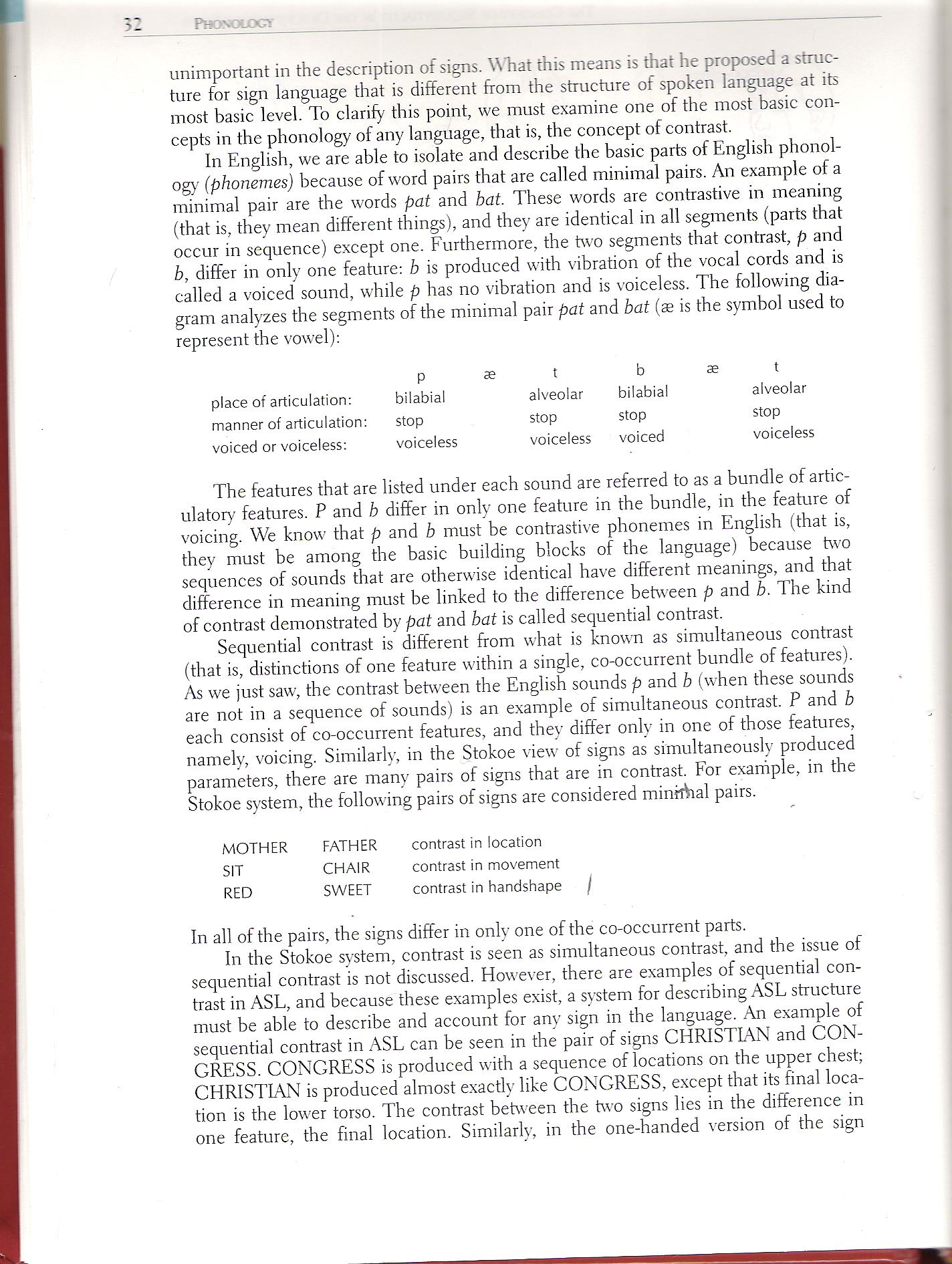15193 Obraz (83)

unimportant in the description of signs. W hat this means is that he proposed a struc-ture for sign language that is different from the structure of spoken language at its most basie level. To clarify this point, we must examine one of the most basie con-cepts in the phonology of any language, that is, the concept of contrast.
In English, we are able to isolate and describe the basie parts of English phonology' (phonemes) because of word pairs that are called minimal pairs. An example of a minimal pair are the words pat and bat. These words are contrastive in meaning (that is, they mean different things), and they are identical in alł segments (parts that occur in seąuence) except one. Furthermore, the two segments that contrast, p and b, differ in only one feature: b is produced with vibration of the vocal cords and is called a voiced sound, while p has no vibration and is voiceless. The following diagram analyzes the segments of the minimal pair pat and bat (se is the symbol used to represent the vowel):
|
p ae |
t |
b |
3S |
t | |
|
place of articulation: |
bilabial |
alveolar |
bilabial |
alveolar | |
|
manner of articulation: |
stop |
stop |
stop |
stop | |
|
voiced or voiceless: |
voiceless |
voiceless |
voiced |
voiceless |
The features that are listed under each sound are referred to as a bundle of artic-ulatory' features. P and b differ in only one feature in the bundle, in the feature of voicing. We know that p and b must be contrastive phonemes in English (that is, they must be among the basie building blocks of the language) because two sequences of sounds that are otherwise identical have different meanings, and that difference in meaning must be linked to the difference between p and b. The kind of contrast demonstrated by pat and bat is called seąuential contrast.
Seąuential contrast is different from what is known as simultaneous contrast (that is, distinctions of one feature within a single, co-occurrent bundle of features). As we just saw, the contrast between the English sounds p and b (when these sounds are not in a seąuence of sounds) is an example of simultaneous contrast. P and b each consist of co-occurrent features, and they differ only in one of those features, namely, voicing. Similarly, in the Stokoe view of signs as simultaneously produced parameters, there are many pairs of signs that are in contrast. For exaniple, in the Stokoe system, the following pairs of signs are considered minrAial pairs.
MOTHER FATHER contrast in location
SIT CHAIR contrast in movement
RED SWEET contrast in handshape /
In all of the pairs, the signs differ in only one of the co-occurrent parts.
In the Stokoe system, contrast is seen as simultaneous contrast, and the issue of seąuential contrast is not discussed. However, there are examples of seąuential contrast in ASL, and because these examples exist, a system for describing ASL structure must be able to describe and account for any sign in the language. An example of seąuential contrast in ASL can be seen in the pair of signs CHRISTIAN and CONGRESS. CONGRESS is produced with a seąuence of locations on the upper chest; CHRISTIAN is produced almost exactly like CONGRESS, except that its finał location is the lower torso. The contrast between the two signs lies in the difference in one feature, the finał location. Similarly, in the one-handed yersion of the sign
Wyszukiwarka
Podobne podstrony:
Obraz (80) UNIT 3The Concept of Seąuentiality in the Description of Signs ~)GOAL To explain why sequ
Obraz (82) The Concept of Skquentiali iy in the Dkscription of Signs 31 FIGURĘ 1
Obraz (84) 33 The Concept of Sequentialpiy in the Dkscription of Signs CHILDREN, the palm orientatio
POSTER SESSION, H6COLLISIONAL BROADENING COEFFICIENTS IN THE i/6 BAND OF CH3F PERTURBED BY RARE GASE
CHAPTER II 18 86230 Inflatlonary praisurts In the occurrence of expanslve spells. This good lenie1
vi VI CONTENTS 10 Romanitas and Realpolitik in Cogitosus Description of the Church of St Brigit
307 (31) 279 Buttons other side of the garment - was recognised in the pieces of 14th-century clothi
więcej podobnych podstron